Yellow Stingray
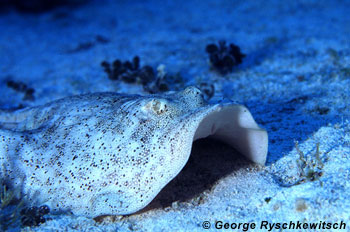
Urobatis jamaicensis
These rays have a round pectoral disc and rounded pelvic fins, no dorsal fins on their short tail, and a venomous spine set back near their small caudal (tail) fin. They prefer sandy bottoms and shallow waters in the Gulf of Mexico and surrounding area of the western Atlantic. They can be found in a variety of colors and patterns of markings, ideal for camouflage when buried in the sand to ambush prey.
They are considered harmless to humans, except during accidental interactions, because they only grow to 26 inches long, and their spine is only used in defense.
Order: Myliobatiformes
Family: Urolophidae
Genus: Urobatis
Species: jamaicensis
Common Names
While Urobatis jamaicensis is commonly call the “yellow stingray”, it has also been referred to as the “round stingray,” “yellow spotted stingray,” and the “maid stingray.” There are many common names for this ray, including Jamaicaanse doornrog (Dutch), pikkukeihäsrausku (Finnish), trygon jamajski (Polish), tembladera (Spanish), raya (Spanish), and raya pintada (Spanish).
Danger to Humans
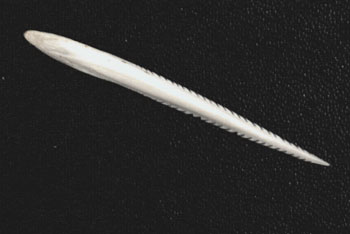
Like most rays, the yellow stingray presents little danger to humans. Stingrays only use their venomous tail spine as a form of defense. Stepping on a stingray is the most common way people are injured by these fish. While being stuck by a stingray spine can be painful, it is rarely life threatening.
Conservation
While not a commercially targeted species, the yellow stingray may be a source of by-catch. Additionally, populations of the yellow stingray can be influenced by a loss of habitat and a reduction in prey sources. U. jamaicensis is currently listed as a species of “Least Concern” with the World Conservation Union (IUCN).
> Check the status of the yellow stingray at the IUCN website.
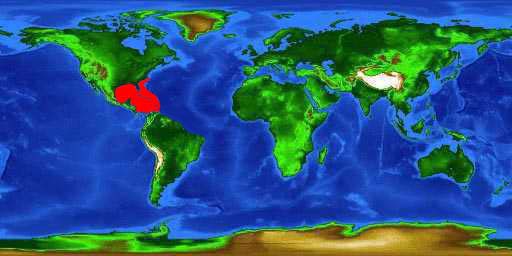
Geographical Distribution
This stingray is found in the coastal waters of the western Atlantic from North Carolina to Florida and throughout the Gulf of Mexico. It is common off the Florida coast, and is occasionally seen in the Bahamas and the Caribbean.
Habitat
U. jamaicensis is most commonly found in shallow water in sandy or muddy habitats, often buried in the substrate. It occurs at depths ranging from less than one foot to 82 feet (25 m). Yellow stingray migration patterns and demography have not been investigated.
Biology
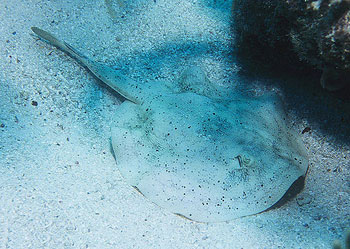
Distinctive Features
Like other rays of the Urolophidae family, the yellow stingray is characterized by a round body. U. jamaicensis has a well developed caudal fin that extends around the tip of its tail. The tail spine is located just anterior to the caudal fin. The distance from the tip of the tail to cloaca is shorter than the distance between the cloaca and snout. Additionally the posterior edge of the pelvic fins are rounded.The yellow stingray lacks a dorsal fin. For additional assistance in identification, see the Coastal Western North Atlantic Stingray Identification Key.
Coloration
While individuals will vary widely in color and pattern, the dorsal side of the disc of U. jamaicensis typically displays one of the following color schemes: a reticulate pattern of dark greenish or brown on a pale background, or equally a close set pattern of minute white, yellow or golden spots on a dark green or brown background. The ventral side of the disc is yellowish or brownish-white in coloration.
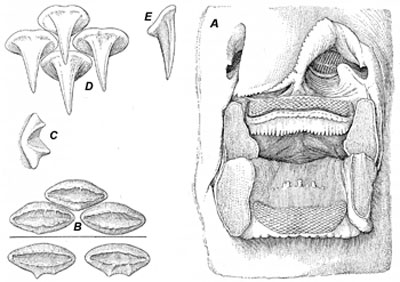
Dentition
There are several papillae located on the floor of the mouth of U. jamaicensis. Both the upper and lower jaws have approximately thirty teeth, with female and immature male specimens having teeth that are oval in shape, possess low cusps, and are closely arranged. However, mature males possess upper teeth that are more loosely spaced and have high conical cusps that are slightly blunt at the end. This sexually dimorphic trait may allow the mature males to better grasp the females during copulation.
Denticles
Newly born rays have skin devoid of denticles. However, shortly after birth the mid-dorsal region begins to roughen with low blunt tubercles. Recurved thorns also develop along the dorsal margin of the caudal fin on both sides. Larger individuals possess mid-dorsal tubercles extending forward to the posterior part of the orbits and in the inter-orbital zone. A lateral band of thorns eventually develops over each shoulder. The ventral side of the ray remains smooth.
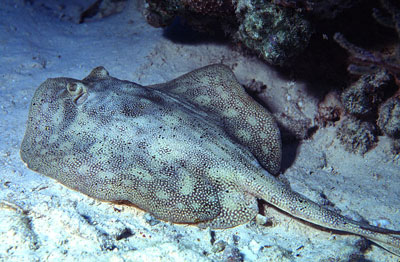
Size, Age, and Growth
To date no study has examined age and growth of U. jamaicensis. Observational data indicate that yellow stingray grows to 26 inches (66 cm) in length with a maximum disc width of approximately 14 inches (35 cm). Examination of the condition of the claspers suggest that males are sexually mature at a disc width of 15-16 cm.
Food Habits
While there is no literature describing U. jamaicensis feeding habits, its method of prey capture may be similar to the round stingray, U. halleri. The round stingray has been observed to scoop out large holes in the muddy or sandy bottom by “waving” its pectoral fins. This action serves to expose any buried worms, crabs or small fish. It has also been suggested that the yellow stingray may attract prey by raising its snout to create a shady area for small fish to hide.
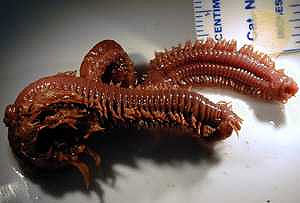
Reproduction
Mating activity has been observed for U. jamaicensis. Male yellow stingrays bite onto a female pectoral fin midway down the margin, allowing him to swing under and assume an abdomen-to-abdomen orientation. This position enables the male to insert one clasper into the female cloaca. One copulation event was observed to last four minutes. The gestation period is not currently known for this ray.
A litter size of three to four has been reported for U. jamaicensis. Embryos have been observed to have discs that are broader relative to their length, than adults. Like other rays of the Urolophidae family, U. jamaicensis embryos possess a fleshy lobe on the inner margin of each spiracle. This lobe conceals most of the spiracle opening. The absence of such a structure in free living young suggests that it is absorbed before or just after birth.
Predators
Any large carnivorous fish, especially sharks such as the tiger shark, is a potential predator of the yellow stingray.
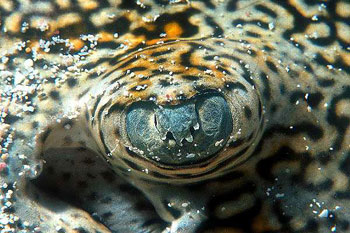
Parasites
Cestodes such as Acanthobothrium cartagenensis, Phyllobothrium kingae, Rhinebothrium magniphallum, and Discobothrium caribbensis are among the endoparasites associated with the yellow stingray.
Taxonomy
The yellow stingray is a member of the Urolophidae (round rays) family. This ray was first described by Cuvier (1816) as Raja jamaicensis. The current nomenclature for the yellow stingray is Urobatus jamaicensis (Cuvier 1816), however most of the literature concerning this ray can be found under the name Urolophus jamaicensis(Cuvier 1816). Junior synonyms include Trygonobatus torpedinus Desmarest 1823 and Urobatis sloani vermiculatus Garman 1913. The currently valid name Urobatis jamaicensis gets its genus name from the Greek words “oura” = tail and “batis” = a ray.
Prepared by: Andrew Piercy